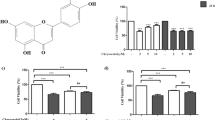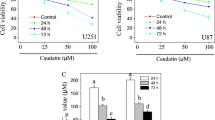Abstract
Anticancer activity of silibinin, a flavonoid, has been demonstrated in various cancer cell types. However, the underlying mechanism and in vivo efficacy in glioma were not elucidated. The present study was undertaken to determine the effect of silibinin on glioma cell proliferation in vitro and to examine whether silibinin inhibits tumor growth in vivo. Silibinin resulted in inhibition of proliferation in a dose- and time-dependent manner, which was largely attributed to cell death. Silibinin induced a transient increase in intracellular Ca2+ followed by an increase in reactive oxygen species (ROS) generation. The silibinin-induced cell death was prevented by EGTA, calpain inhibitor and antioxidants (N-acetylcysteine and Trolox). Western blot analysis showed that silibinin also induced ROS-dependent activation of extracellular signal-regulated kinase, p38 kinase, and c-Jun N-terminal kinase. Inhibitors of these kinases prevented the silibinin-induced cell death. Silibinin caused caspase activation and the silibinin-induced cell death was prevented by caspase inhibitors. Glioma cell migration was also decreased by silibinin treatment. Oral administration of silibinin in animals with subcutaneous U87MG glioma cells reduced tumor volume. Subsequent tumor tissue analysis showed a decrease in Ki-67 positive cells, an increase in TUNEL-positive cells, and caspase activation. These results indicate that silibinin induces a caspase-dependent cell death via Ca2+/ROS/MAPK-mediated pathway in vitro and inhibits glioma growth in vivo. These data suggest that silibinin may serve as a potential therapeutic agent for malignant human gliomas.









Similar content being viewed by others
References
Ohgaki H, Kleihues P (2005) Population-based studies on incidence, survival rates, and genetic alterations in astrocytic and oligodendroglial gliomas. J Neuropathol Exp Neurol 64(6):479–489
DeAngelis LM (2001) Brain tumors. N Engl J Med 344(2):114–123. doi:10.1056/NEJM200101113440207
Sanai N, Alvarez-Buylla A, Berger MS (2005) Neural stem cells and the origin of gliomas. N Engl J Med 353(8):811–822. doi:10.1056/NEJMra043666
Kanadaswami C, Lee LT, Lee PP, Hwang JJ, Ke FC, Huang YT, Lee MT (2005) The antitumor activities of flavonoids. In Vivo 19(5):895–909
Ren W, Qiao Z, Wang H, Zhu L, Zhang L (2003) Flavonoids: promising anticancer agents. Med Res Rev 23(4):519–534. doi:10.1002/med.10033
Fresco P, Borges F, Diniz C, Marques MP (2006) New insights on the anticancer properties of dietary polyphenols. Med Res Rev 26(6):747–766. doi:10.1002/med.20060
Braganhol E, Zamin LL, Canedo AD, Horn F, Tamajusuku AS, Wink MR, Salbego C, Battastini AM (2006) Antiproliferative effect of quercetin in the human U138MG glioma cell line. Anticancer Drugs 17(6):663–671. doi:10.1097/01.cad.0000215063.23932.02
Shen SC, Lin CW, Lee HM, Chien LL, Chen YC (2006) Lipopolysaccharide plus 12-o-tetradecanoylphorbol 13-acetate induction of migration and invasion of glioma cells in vitro and in vivo: differential inhibitory effects of flavonoids. Neuroscience 140(2):477–489. doi:10.1016/j.neuroscience.2006.02.028
Sharma V, Joseph C, Ghosh S, Agarwal A, Mishra MK, Sen E (2007) Kaempferol induces apoptosis in glioblastoma cells through oxidative stress. Mol Cancer Ther 6(9):2544–2553. doi:10.1158/1535-7163.MCT-06-0788
Singh RP, Gu M, Agarwal R (2008) Silibinin inhibits colorectal cancer growth by inhibiting tumor cell proliferation and angiogenesis. Cancer Res 68(6):2043–2050. doi:10.1158/0008-5472.CAN-07-6247
Singh RP, Mallikarjuna GU, Sharma G, Dhanalakshmi S, Tyagi AK, Chan DC, Agarwal C, Agarwal R (2004) Oral silibinin inhibits lung tumor growth in athymic nude mice and forms a novel chemocombination with doxorubicin targeting nuclear factor kappaB-mediated inducible chemoresistance. Clin Cancer Res 10(24):8641–8647. doi:10.1158/1078-0432.CCR-04-1435
Ramasamy K, Agarwal R (2008) Multitargeted therapy of cancer by silymarin. Cancer Lett 269:352–362
Kaur M, Agarwal R (2007) Silymarin and epithelial cancer chemoprevention: how close we are to bedside? Toxicol Appl Pharmacol 224(3):350–359. doi:10.1016/j.taap.2006.11.011
Hoh C, Boocock D, Marczylo T, Singh R, Berry DP, Dennison AR, Hemingway D, Miller A, West K, Euden S, Garcea G, Farmer PB, Steward WP, Gescher AJ (2006) Pilot study of oral silibinin, a putative chemopreventive agent, in colorectal cancer patients: silibinin levels in plasma, colorectum, and liver and their pharmacodynamic consequences. Clin Cancer Res 12(9):2944–2950. doi:10.1158/1078-0432.CCR-05-2724
Flaig TW, Gustafson DL, Su LJ, Zirrolli JA, Crighton F, Harrison GS, Pierson AS, Agarwal R, Glode LM (2007) A phase I and pharmacokinetic study of silybin-phytosome in prostate cancer patients. Invest New Drugs 25(2):139–146. doi:10.1007/s10637-006-9019-2
Schroder FH, Roobol MJ, Boeve ER, de Mutsert R, Zuijdgeest-van Leeuwen SD, Kersten I, Wildhagen MF, van Helvoort A (2005) Randomized, double-blind, placebo-controlled crossover study in men with prostate cancer and rising PSA: effectiveness of a dietary supplement. Eur Urol 48(6):922–930. doi:10.1016/j.eururo.2005.08.005 discussion 930-921
Qi L, Singh RP, Lu Y, Agarwal R, Harrison GS, Franzusoff A, Glode LM (2003) Epidermal growth factor receptor mediates silibinin-induced cytotoxicity in a rat glioma cell line. Cancer Biol Ther 2(5):526–531
Son YG, Kim EH, Kim JY, Kim SU, Kwon TK, Yoon AR, Yun CO, Choi KS (2007) Silibinin sensitizes human glioma cells to TRAIL-mediated apoptosis via DR5 up-regulation and down-regulation of c-FLIP and survivin. Cancer Res 67(17):8274–8284. doi:10.1158/0008-5472.CAN-07-0407
Denizot F, Lang R (1986) Rapid colorimetric assay for cell growth and survival. Modifications to the tetrazolium dye procedure giving improved sensitivity and reliability. J Immunol Methods 89(2):271–277. doi:10.1016/0022-1759(86)90368-6
Orrenius S, Zhivotovsky B, Nicotera P (2003) Regulation of cell death: the calcium-apoptosis link. Nat Rev Mol Cell Biol 4(7):552–565. doi:10.1038/nrm1150
Cobb MH (1999) MAP kinase pathways. Prog Biophys Mol Biol 71(3–4):479–500. doi:10.1016/S0079-6107(98)00056-X
Cross TG, Scheel-Toellner D, Henriquez NV, Deacon E, Salmon M, Lord JM (2000) Serine/threonine protein kinases and apoptosis. Exp Cell Res 256(1):34–41. doi:10.1006/excr.2000.4836
Martindale JL, Holbrook NJ (2002) Cellular response to oxidative stress: signaling for suicide and survival. J Cell Physiol 192(1):1–15
Cohen GM (1997) Caspases: the executioners of apoptosis. Biochem J 326:1–16
Singh RP, Tyagi A, Sharma G, Mohan S, Agarwal R (2008) Oral silibinin inhibits in vivo human bladder tumor xenograft growth involving down-regulation of survivin. Clin Cancer Res 14(1):300–308. doi:10.1158/1078-0432.CCR-07-1565
Hajnoczky G, Davies E, Madesh M (2003) Calcium signaling and apoptosis. Biochem Biophys Res Commun 304(3):445–454. doi:10.1016/S0006-291X(03)00616-8
Huang Y, Wang KK (2001) The calpain family and human disease. Trends Mol Med 7(8):355–362. doi:10.1016/S1471-4914(01)02049-4
Vanags DM, Porn-Ares MI, Coppola S, Burgess DH, Orrenius S (1996) Protease involvement in fodrin cleavage and phosphatidylserine exposure in apoptosis. J Biol Chem 271(49):31075–31085. doi:10.1074/jbc.271.49.31075
Chen YC, Shen SC, Chow JM, Ko CH, Tseng SW (2004) Flavone inhibition of tumor growth via apoptosis in vitro and in vivo. Int J Oncol 25(3):661–670
Wang IK, Lin-Shiau SY, Lin JK (1999) Induction of apoptosis by apigenin and related flavonoids through cytochrome c release and activation of caspase-9 and caspase-3 in leukaemia HL-60 cells. Eur J Cancer 35(10):1517–1525. doi:10.1016/S0959-8049(99)00168-9
Kim EJ, Choi CH, Park JY, Kang SK, Kim YK (2008) Underlying mechanism of quercetin-induced cell death in human glioma cells. Neurochem Res 33(6):971–979. doi:10.1007/s11064-007-9416-8
Thor H, Hartzell P, Orrenius S (1984) Potentiation of oxidative cell injury in hepatocytes which have accumulated Ca2+. J Biol Chem 259(10):6612–6615
Grijalba MT, Vercesi AE, Schreier S (1999) Ca2 + -induced increased lipid packing and domain formation in submitochondrial particles. A possible early step in the mechanism of Ca2 + -stimulated generation of reactive oxygen species by the respiratory chain. Biochemistry 38(40):13279–13287. doi:10.1021/bi9828674
Dykens JA (1994) Isolated cerebral and cerebellar mitochondria produce free radicals when exposed to elevated CA2 + and Na + : implications for neurodegeneration. J Neurochem 63(2):584–591
Lee SJ, Kim MS, Park JY, Woo JS, Kim YK (2008) 15-Deoxy-delta 12, 14-prostaglandin J2 induces apoptosis via JNK-mediated mitochondrial pathway in osteoblastic cells. Toxicology 248(2–3):121–129. doi:10.1016/j.tox.2008.03.014
Kwon CH, Yoon CS, Kim YK (2007) Ciglitazone induces caspase-independent apoptosis via p38-dependent AIF nuclear translocation in renal epithelial cells. Toxicology 244:13–24
Jung JY, Yoo CI, Kim HT, Kwon CH, Park JY, Kim YK (2007) Role of mitogen-activated protein kinase (MAPK) in troglitazone-induced osteoblastic cell death. Toxicology 234(1–2):73–82. doi:10.1016/j.tox.2007.02.005
Oh HL, Seok JY, Kwon CH, Kang SK, Kim YK (2006) Role of MAPK in ceramide-induced cell death in primary cultured astrocytes from mouse embryonic brain. Neurotoxicology 27(1):31–38. doi:10.1016/j.neuro.2005.05.008
Lee WC, Choi CH, Cha SH, Oh HL, Kim YK (2005) Role of ERK in hydrogen peroxide-induced cell death of human glioma cells. Neurochem Res 30:263–270
Bhat NR, Zhang P (1999) Hydrogen peroxide activation of multiple mitogen-activated protein kinases in an oligodendrocyte cell line: role of extracellular signal-regulated kinase in hydrogen peroxide-induced cell death. J Neurochem 72(1):112–119. doi:10.1046/j.1471-4159.1999.0720112.x
Brand A, Gil S, Seger R, Yavin E (2001) Lipid constituents in oligodendroglial cells alter susceptibility to H2O2-induced apoptotic cell death via ERK activation. J Neurochem 76(3):910–918. doi:10.1046/j.1471-4159.2001.00085.x
Mallikarjuna G, Dhanalakshmi S, Singh RP, Agarwal C, Agarwal R (2004) Silibinin protects against photocarcinogenesis via modulation of cell cycle regulators, mitogen-activated protein kinases, and Akt signaling. Cancer Res 64(17):6349–6356. doi:10.1158/0008-5472.CAN-04-1632
Nguyen TT, Tran E, Nguyen TH, Do PT, Huynh TH, Huynh H (2004) The role of activated MEK-ERK pathway in quercetin-induced growth inhibition and apoptosis in A549 lung cancer cells. Carcinogenesis 25(5):647–659. doi:10.1093/carcin/bgh052
Russo M, Palumbo R, Tedesco I, Mazzarella G, Russo P, Iacomino G, Russo GL (1999) Quercetin and anti-CD95(Fas/Apo1) enhance apoptosis in HPB-ALL cell line. FEBS Lett 462(3):322–328. doi:10.1016/S0014-5793(99)01544-6
Yang JH, Hsia TC, Kuo HM, Chao PD, Chou CC, Wei YH, Chung JG (2006) Inhibition of lung cancer cell growth by quercetin glucuronides via G2/M arrest and induction of apoptosis. Drug Metab Dispos 34(2):296–304. doi:10.1124/dmd.105.005280
Punathil T, Tollefsbol TO, Katiyar SK (2008) EGCG inhibits mammary cancer cell migration through inhibition of nitric oxide synthase and guanylate cyclase. Biochem Biophys Res Commun 375(1):162–167. doi:10.1016/j.bbrc.2008.07.157
Chen PN, Chu SC, Chiou HL, Kuo WH, Chiang CL, Hsieh YS (2006) Mulberry anthocyanins, cyanidin 3-rutinoside and cyanidin 3-glucoside, exhibited an inhibitory effect on the migration and invasion of a human lung cancer cell line. Cancer Lett 235(2):248–259. doi:10.1016/j.canlet.2005.04.033
Albini A, Dell’Eva R, Vene R, Ferrari N, Buhler DR, Noonan DM, Fassina G (2006) Mechanisms of the antiangiogenic activity by the hop flavonoid xanthohumol: NF-kappaB and Akt as targets. FASEB J 20(3):527–529
Acknowledgments
This work was supported by the MRC program of MOST/KOSEF (R13-2005-009) in Korea.
Author information
Authors and Affiliations
Corresponding author
Rights and permissions
About this article
Cite this article
Kim, K.W., Choi, C.H., Kim, T.H. et al. Silibinin Inhibits Glioma Cell Proliferation via Ca2+/ROS/MAPK-Dependent Mechanism In Vitro and Glioma Tumor Growth In Vivo. Neurochem Res 34, 1479–1490 (2009). https://doi.org/10.1007/s11064-009-9935-6
Accepted:
Published:
Issue Date:
DOI: https://doi.org/10.1007/s11064-009-9935-6




